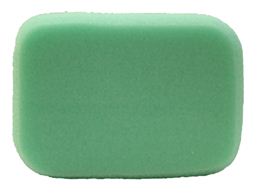Ok, so I thought a sponge was a sponge, but of course I should have known better. For some years now we in the tiling world have had hydrophilic sponges – sponges designed to be highly absorbent for maximum clean-up performance when grouting. They are a little more dense than a standard sponge, such as you may use for washing a car for example. But they do not make good applicators for sealers. The reason is each squeeze of the sponge causes sealers to foam up and this should be avoided. Also, most normal sponges will not hold the sealer and therefore drip it out all over the floor as soon as you lift it out of the sealer container (assuming you are using a paint tray of course), so you have no control of the flow. The hydro sponges on the other hand don’t let enough sealer out.
So I have never been a fan of using a sponge to apply sealers in general (save the sponge brushes which can be useful for grout sealing). Similarly, I tend not to recommend the use of rollers (whether sponge or fleece), but this has as much to do with the way that rollers can put too much product down and also of course there is the rolling action itself which can cause unwanted splashes.
My preferred method for the application of most sealers is a good quality paint pad, they seem to hold just the right amount of product and let it out evenly. However, I have just discovered Sealer Sponges, designed to hold sealer and let it out when you want it to. I have tried them and have to say I am quite impressed. I would still use paint pads for larger jobs but these are great for the little jobs. They are especially good for applying coating sealers with nice, flat even coats.
Copyright Ian Taylor and The Tile and Stone Blog.co.uk, 2013. See copyright notice above.


Leave a Reply